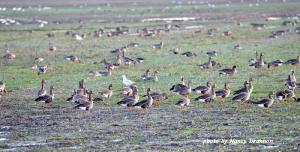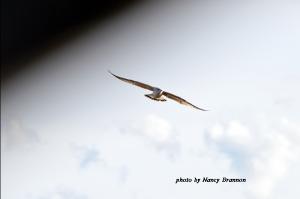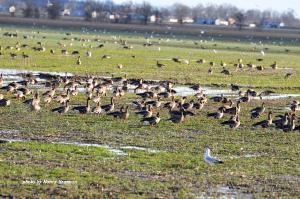By Nancy Brannon
Coming back from covering an equestrian event at the Tunica arena on January 18, 2020, I saw large flocks of Greater White-fronted Geese, along with some Ring Billed Gulls, browsing the harvested fields off Highway 61 and Highway 304/Casino Strip Resort Blvd.
The Cornell Lab’s All About Birds website gives good information about these migratory visitors to the Mississippi Delta.
“The Greater White-fronted Goose is a stocky brown goose that occurs across the Northern Hemisphere and in North America is found mainly west of the Mississippi. It sports white feathers around its pinkish orange bill, orange legs, and a white line down its side. These geese breed in arctic tundra and winter in large flocks in wetlands, lakes, and croplands.
“As is true of many geese, Greater White-fronted Goose pairs stay together for years and migrate together, along with their offspring. White-fronted Goose family bonds can last longer than in most geese, and some young stay with their parents through the next breeding season. Parent and sibling associations may continue throughout their lives.
“The best time to go looking for a Greater White-fronted Goose over much of the United States is during migration. From February through May, and again from September through November, look for Greater White-fronted Geese foraging in agricultural fields or resting on lakes and ponds.”
The following day, Sunday January 19, Delta Wind Birds paired with Strawberry Plains Audubon Center to co-sponsor the annual North Delta Birding trip, but a bit further south, in the Batesville, Miss. area, touring the agriculture lands of Panola County.
Jason Hoeksema, President of Delta Wind Birds said about 35 people joined the bird watching group, which saw Snow Geese, Ross’s Geese and Greater White-fronted Geese. “We saw a flock of at least 5,000 Snow Geese,” he said.
“Sometimes the Ross’s Geese are mixed in with them. We also saw Greater White-fronted Geese: at least two flocks with a couple hundred birds in each. We saw ducks, too: Northern Pintails, Northern Shovelers. And we saw some songbirds, like Horned Larks and Vesper Sparrows. We also saw Sandhill Cranes,” which typically spend each winter here. Hoeksema was pleased with the turnout of bird watchers and the types of birds they were able to view.
Hoeksema said that “part of Delta Wind Bird’s mission is educational – promoting understanding and appreciating the birds and habitats of Mississippi, especially the Delta. Our other mission is to work with private landowners to create habitat for migratory birds in the Delta.”
To join upcoming events with Delta Wind Birds, visit http://deltawindbirds.org/events/. To learn more about DWB’s habitat program, visit http://deltawindbirds.org/habitat-programs/
Strawberry Plains’ Mitch Robinson said: “The over 30 participants spent from 8 am – 2 pm birding throughout Panola County. Despite the wind and frigid temperatures, it was a gorgeous day and we had a great time. There were several first time birders and a great diversity of folks, ranging from teenagers up to seniors.
“Here is a list of species of interest from our trip:
5000 Snow Geese
200 Ross’s Geese
450 Greater White-fronted Geese
Several White-crowned Sparrows (as well as Vesper, Savannah, Song, and Swamp Sparrows)
Loggerhead Shrike
Northern Harrier
300 Red-winged Blackbirds
100 Killdeer
10 Horned Larks
Eastern Meadowlark
Sandhill Cranes
Several Red-tailed and Red-shouldered Hawks
Northern Flicker”
To connect with folks at Strawberry Plains Audubon Center, visit: https://strawberry.audubon.org/
Find more information about these geese at: https://www.allaboutbirds.org/guide/Greater_White-fronted_Goose/overview and at: https://www.audubon.org/field-guide/bird/greater-white-fronted-goose
Coming back from covering an equestrian event at the Tunica arena on January 18, 2020, I saw large flocks of Greater White-fronted Geese, along with some Ring Billed Gulls, browsing the harvested fields off Highway 61 and Highway 304/Casino Strip Resort Blvd.
The Cornell Lab’s All About Birds website gives good information about these migratory visitors to the Mississippi Delta.
“The Greater White-fronted Goose is a stocky brown goose that occurs across the Northern Hemisphere and in North America is found mainly west of the Mississippi. It sports white feathers around its pinkish orange bill, orange legs, and a white line down its side. These geese breed in arctic tundra and winter in large flocks in wetlands, lakes, and croplands.
“As is true of many geese, Greater White-fronted Goose pairs stay together for years and migrate together, along with their offspring. White-fronted Goose family bonds can last longer than in most geese, and some young stay with their parents through the next breeding season. Parent and sibling associations may continue throughout their lives.
“The best time to go looking for a Greater White-fronted Goose over much of the United States is during migration. From February through May, and again from September through November, look for Greater White-fronted Geese foraging in agricultural fields or resting on lakes and ponds.”
The following day, Sunday January 19, Delta Wind Birds paired with Strawberry Plains Audubon Center to co-sponsor the annual North Delta Birding trip, but a bit further south, in the Batesville, Miss. area, touring the agriculture lands of Panola County.
Jason Hoeksema, President of Delta Wind Birds said about 35 people joined the bird watching group, which saw Snow Geese, Ross’s Geese and Greater White-fronted Geese. “We saw a flock of at least 5,000 Snow Geese,” he said.
“Sometimes the Ross’s Geese are mixed in with them. We also saw Greater White-fronted Geese: at least two flocks with a couple hundred birds in each. We saw ducks, too: Northern Pintails, Northern Shovelers. And we saw some songbirds, like Horned Larks and Vesper Sparrows. We also saw Sandhill Cranes,” which typically spend each winter here. Hoeksema was pleased with the turnout of bird watchers and the types of birds they were able to view.
Hoeksema said that “part of Delta Wind Bird’s mission is educational – promoting understanding and appreciating the birds and habitats of Mississippi, especially the Delta. Our other mission is to work with private landowners to create habitat for migratory birds in the Delta.”
To join upcoming events with Delta Wind Birds, visit http://deltawindbirds.org/events/. To learn more about DWB’s habitat program, visit http://deltawindbirds.org/habitat-programs/
Strawberry Plains’ Mitch Robinson said: “The over 30 participants spent from 8 am – 2 pm birding throughout Panola County. Despite the wind and frigid temperatures, it was a gorgeous day and we had a great time. There were several first time birders and a great diversity of folks, ranging from teenagers up to seniors.
“Here is a list of species of interest from our trip:
5000 Snow Geese
200 Ross’s Geese
450 Greater White-fronted Geese
Several White-crowned Sparrows (as well as Vesper, Savannah, Song, and Swamp Sparrows)
Loggerhead Shrike
Northern Harrier
300 Red-winged Blackbirds
100 Killdeer
10 Horned Larks
Eastern Meadowlark
Sandhill Cranes
Several Red-tailed and Red-shouldered Hawks
Northern Flicker”
To connect with folks at Strawberry Plains Audubon Center, visit: https://strawberry.audubon.org/
Find more information about these geese at: https://www.allaboutbirds.org/guide/Greater_White-fronted_Goose/overview and at: https://www.audubon.org/field-guide/bird/greater-white-fronted-goose







![Paso Fino Pleasure_Amateur Owner [Class 650]](https://midsouthhorsereview.com/old website/admin/files/news_7571_small_bJaEKlV8.jpg)



